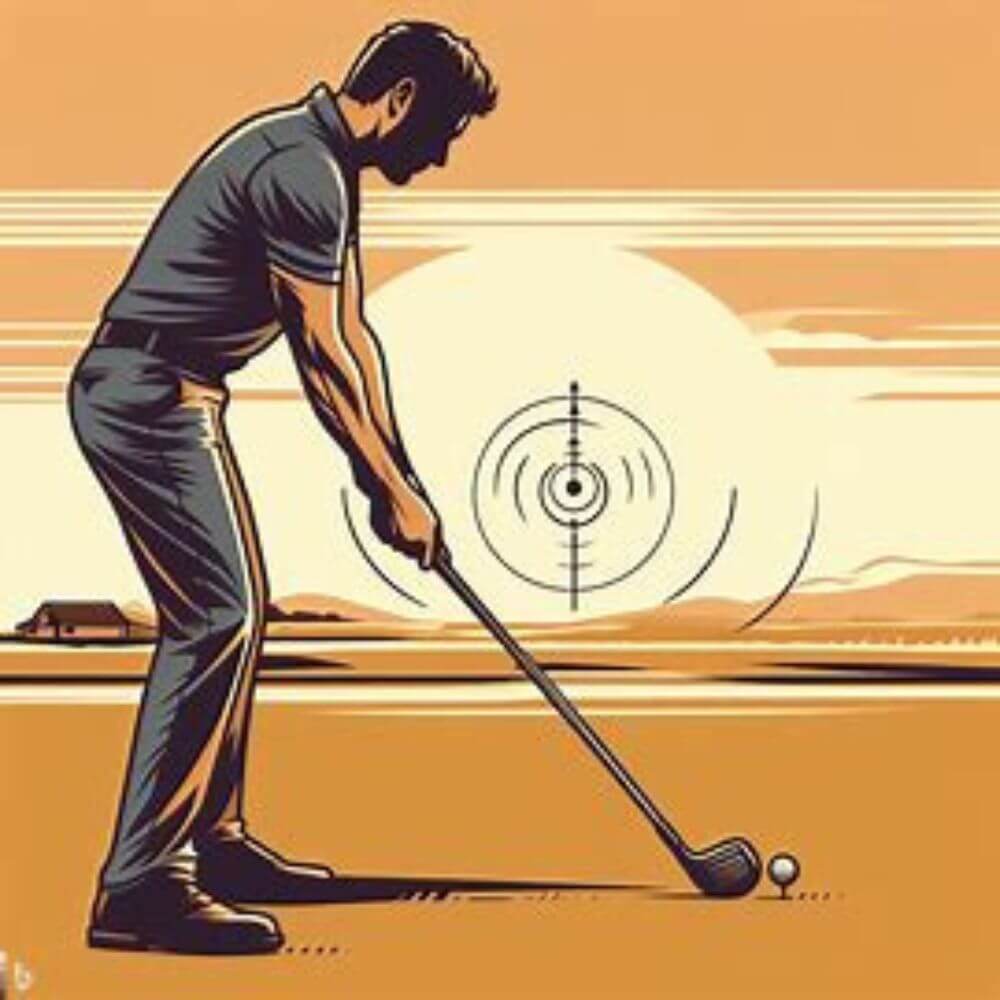Content Summary
I know many golfers like to get their instruction from YouTube. This is ok to a point. There are so many different instructors with so many different techniques that it can cause massive confusion for folks once they take it out to the course and find it doesn't work.
The reason is simple, when you make a change in one area of your swing it can affect another area without you being aware of it.
For beginners, this is even more important. Ingraining bad habits now can last a lifetime. Trust me, I know from first-hand experience.
I believe the best way for beginners to start their journey is to get professional help for the fundamentals of the swing and then they can better understand how one change here can change something over there.
Key Takeaways:
- Proper setup and grip essential for beginners
- Common mistakes like slicing must be diagnosed and corrected
- Tempo, swing plane, ball position key for control and power
- Consistency takes practice and drilling of proper mechanics
- Getting lessons and coaching accelerates development
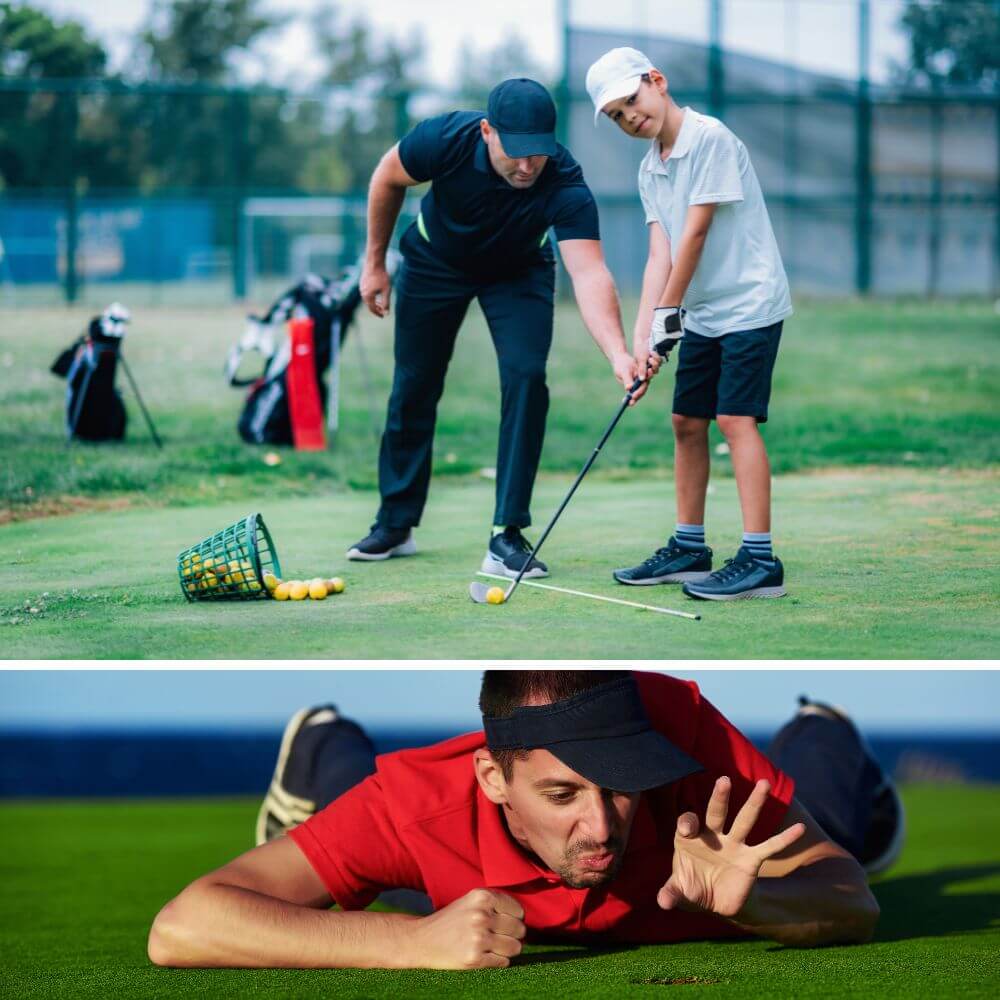
Proper Golf Setup Posture
1. Finding the Proper Grip for a Beginner Golf Swing
A proper and consistent golf grip is crucial for beginner golfers looking to develop a sound swing. Your grip determines how the club face is positioned at impact, which controls the launch angle of the golf ball, spin rate, and ultimately the flight path.
Mastering grip early in your development will pay huge dividends in building repeatable golf club swing mechanics allowing you to play golf that is fun.
Types of Grips
There are three main types of golf grips that beginners should be aware of:
- Overlapping (Vardon) Grip: The trailing hand's pinky finger overlaps the lead hand's index finger. This is a very common grip style.
- Interlocking Grip: The pinky finger of the trail hand interlocks with the index finger of the lead hand. This connects the hands.
- Baseball or Ten-Finger Grip: All ten fingers press against the handle in parallel with a gap between the hands. Less common for beginners.
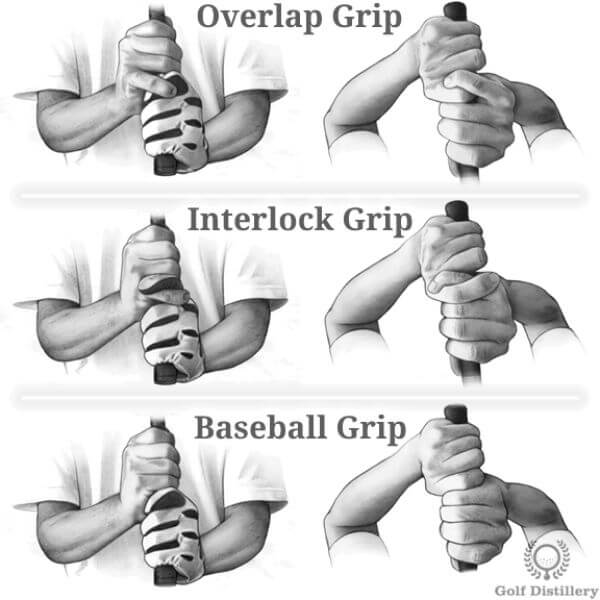
Many instructors recommend the overlapping grip as the easiest and most effective for novice players. But it ultimately comes down to comfort level and what allows you to make consistent contact. I use the overlapping grip since this is the most comfortable for me.
Proper Hand Placement
The correct placement of both hands on the club is critical. Here are some key tips:
- Place the handle in the fingers of your lead hand, not the palm. This enhances feeling and control.
- Ensure your lead hand grip aligns properly down the heel pad. Rotate it counterclockwise slightly.
- Keep lead arm and club face square at address. Don't allow the wrist to hinge backward.
- Let the lifeline of your trail hand run directly down the top of the shaft. Keep wrist flat.
- Position both thumbs straight down the middle of the shaft, not angled inward.
Proper hand placement promotes proper club delivery and face angle through impact.
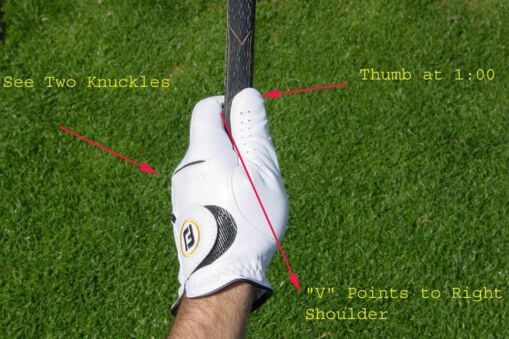
Pressure Points
Applying the correct grip pressure is also important for beginners:
- Maintain light overall pressure in fingers and palms. Don't death grip the club.
- Use the last three fingers of the lead hand mainly to support and hold the club.
- Allow the index finger and thumb of the lead hand to apply lighter pressure for control.
- The trail hand mainly provides stability, with the thumb applying very light pressure.
Uneven grip pressure leads to hand and wrist tension that inhibits a fluid, free golf swing.
Common Beginner Grip Mistakes
Here are some of the most frequent grip errors beginners make:
- Gripping too tightly in palms and hands instead of fingers.
- Lead hand rotating too far clockwise with incorrect heel pad position.
- Hands and wrists feeling tension and rigidity during swing.
- Thumbs pointing inward down the shaft instead of central.
- Trail hand turned too far clockwise under the club.
- Handle resting more in palm instead of fingers.
Being aware of these miscues helps correct them early before they become ingrained habits.
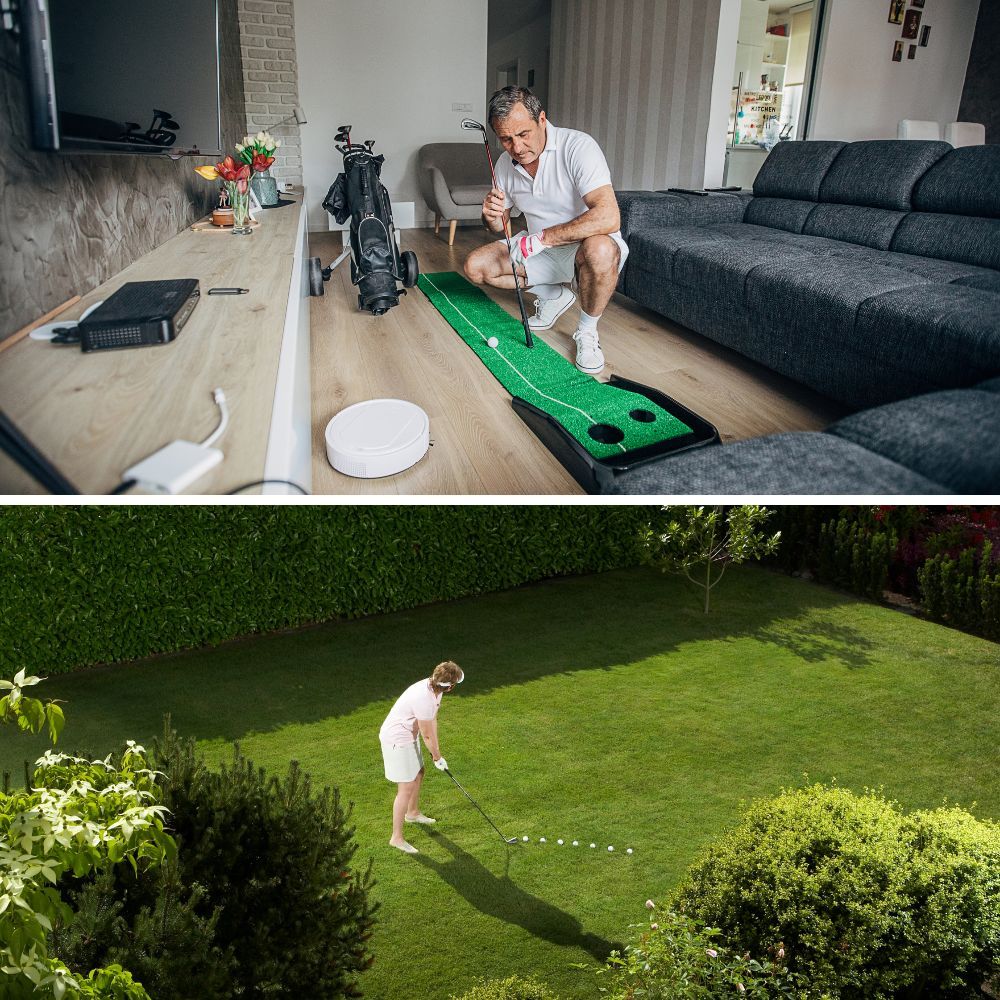
How to Practice Golf at Home
Drills for Proper Grip
Regularly practicing proper grip technique off the course is essential. Here are some useful training drills:
- Daily practice swings - Take slow, smooth practice swings daily, focusing on proper grip positions.
- Towel or ball under trail arm - Helps learn proper wrist flatness.
- Forearm rope rotations - Isolates turning shoulders and torso instead of hands and arms.
- Impact bag release drills - Grooves letting the club hinge and release naturally.
- Perfect address rehearsals - Assume the ideal address position and grip slowly and repeatedly.
Grooving muscle memory of correct grip patterns takes conscious repetition.
Grip Aids
Various grip training aids can assist beginners:
- Impact bags - Teaches correct wrist hinge and release.
- Training grips - Guides proper hand placement and pressure.
- Grip guides - Keep palms and wrists in an ideal position.
- Wrist aligners - Provide tactile feedback on angulation.
When paired with professional instruction, grip aids can accelerate skill development.
Benefits of Proper Grip
Here are some of the key benefits that a technically sound grip provides for beginner golfers:
- Allows consistent club face control through impact.
- Provides power and compression without twisting hands.
- Reduces tension in hands, wrists, and forearms.
- Promotes proper backswing hinging and follow-through.
- Enables draw or fade ball flights on command.
- Builds solid base for repeatable overall swing.
Investing time to learn proper beginner grip form will amplify your potential to gain skills quickly. Be sure to get professional instruction to correct any flaws early before they become permanent. Mastering grip technique will lay the bedrock for a lifetime of improved play and enjoyment on the course.
2. Fixing a Slice in Your Beginner Golf Swing
Slicing the ball, where shots bend dramatically off target to the right, is an extremely common problem for beginner golfers. A slice is usually caused by an open club face and an over-the-top swing path through impact. With some basic adjustments, however, you can eliminate slices and get your new swing on plane.
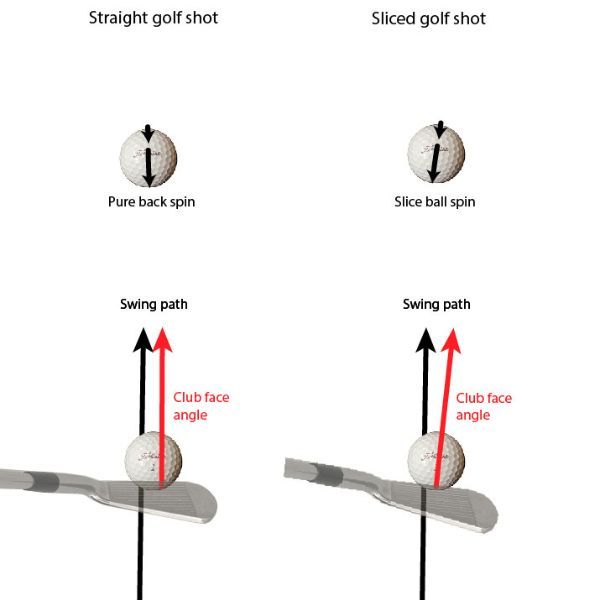
Diagnosing Your Slice
First, analyze your swing to understand why you're slicing the ball:
- Club face alignment - Is the face open relative to the target at impact? This imparts a clockwise sidespin.
- Swing path - Does the club come too far from the inside on the downswing? This amplifies an open face.
- Grip and wrist action - Do wrists roll open before impact, opening the face?
- Ball position - Is the ball too far forward at address, contributing to an open face?
Finding the root cause is key to correcting it.
Grip and Setup Positions
One common slicer's mistake is a weak grip that allows the club face to open:
- Strengthen grip - Rotate both hands slightly clockwise on the club.
- Check wrist angles - Ensure wrists are flat, not cupped or bowed.
- Square clubface - Align the face directly at the target at address.
Similarly, improper setup can trigger over-the-top swings:
- Wider stance - This shallows the swing plane.
- Limit knee bend - Reducing flex promotes an outside-in path.
- Ball position - Playing too far forward encourages slices.
Swing Path Adjustments
Often a swing coming too far from the inside causes path-induced slices:
- Feel the proper plane - Use drills like alignment sticks to sense correct geometry.
- Shallow the downswing - Maintain width coming down to prevent over-the-top motion.
- Weakening grip - This holds the face open in relation to the swing path.
- "No rolling" - Avoid letting wrists hinge open before impact.
Swing path training engrains the proper palm-up/palm-down orientation.
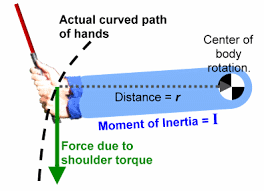
Moment of Inertia in Golf Swing
Equipment Set Up
Having properly fit equipment can also help straighten mis-hit shots:
- Driver loft - Increase loft to reduce sidespin and decrease slicing.
- Shaft flex - Stiffer flexes slow clubface closing for some players.
- Club length - Shorter shafts provide control for slower swing speeds.
- Heavier clubhead - Added mass reduces open-face twisting.
See your local pro shop for fitting advice tailored to your swing.
Drills to Cure Slicing
Ingraining the correct motions takes practice. Helpful drills include:
- "Box drill" - Make practice swings between two alignments sticks to sense the proper plane.
- Impact bag - Grooves releasing the wrists fully through impact.
- Proper grip rehearsals - Repeat proper hand positioning and pressure in practice.
- Half-swing follow-throughs - Exaggerate palm facing downwards and around the body.
- Target swings - Pick intermediate targets to shallow swing plane.
Be sure to get professional instruction to correct any technical flaws.
Common Anti-Slice Tips
Here are some other quick tips to stop slicing:
- Close the clubface slightly at address.
- Tee the ball in line with the club you are using.
- Make a slight weight shift towards your lead foot.
- Swing slightly more around your body.
- Keep lead arm connected to chest in downswing.
- Slightly delay releasing the clubhead.
Test different remedies to determine which works best for your swing.
Benefits of Straightening Your Shots
Learning to control your shot shape provides huge advantages:
- More fairways and greens hit for lower scores.
- Ability to shape intentional fades or draws.
- Consistently solid ball-striking.
- Improved directional control.
- Enhanced confidence standing over every shot.
Curing your slicing issues early in your golf journey will put you on the path to rapidly improving and developing sound mechanics. Be patient with the process, get professional help when needed, and your shots will be flying straight in no time.
3. Achieving the Proper Backswing for Beginner Golfers
A technically sound backswing establishes the foundation for consistent ball-striking. For beginners, focusing on proper positions in the takeaway and at the top lays the groundwork for solid overall mechanics.
Mastering key elements like wrist hinging, arm positioning, and shoulder turns early creates an efficient motion to maximize both power and control.
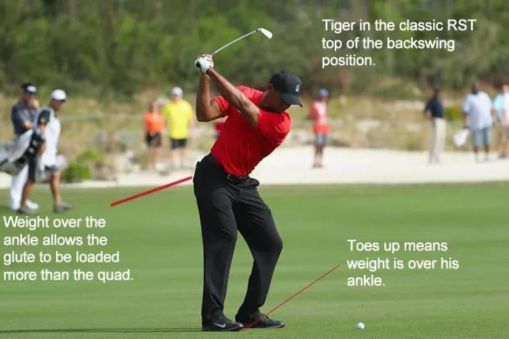
Backswing Goals
The primary objectives during an effective beginner backswing are:
- Keeping the clubface square to the target line as long as possible
- Maintaining spine angle and posture
- Achieving a full 90° shoulder turn
- Not swaying off the ball or swaying hips excessively
- Allowing the arms and club to swing freely around the body
- Transferring weight smoothly to the back foot
Achieving these positions builds stability and coiling power.
Common Backswing Errors
Some common mistakes to avoid include:
- Overly restricted shoulder turn due to poor posture
- Excessive lateral sway off the ball during the takeaway
- Rolling the wrists and forearms too early or too much
- Lifting or straightening up during the backswing
- Too much secondary spine tilt away from the target
- Gripping down and restricting the wrist hinge
Detecting these mistakes yourself or with a coach is key to correcting them.
Drills for Proper Backswing
Grooving a technically sound backswing requires practice and conscious repetition. Helpful drills include:
- Wall turns - Make backswings with the lead arm against a wall to feel shoulder rotation with stability.
- Alignment stick checks - Place a stick across the shoulders to monitor unwanted secondary tilt.
- Quarter-swing takeaways - Make small, smooth swing arcs checking positions.
- Overclub swings - Encourages compact, connected takeaway with a longer club.
- Split grip - Eliminates excessive wrist break by separating hands.
- Mirror and video - Check positions visually to build a kinesthetic feel.
Performing drills ingrains proper sequencing and feels.
Backswing Position Checkpoints
Here are key positions to monitor moving the club back:
Takeaway
- Feet slightly wider than shoulder-width
- Weight evenly distributed or slightly toward trail foot
- Wrists hinged naturally, not forcibly
Mid-Backswing
- Hands at belt-buckle height
- Lead arm across chest, trail arm tucked close to the body
- Approximately 45° shoulder and hip turn
Top of Backswing
- Approximately 90° shoulder turn; hips turned less
- Arms fully extended but not past parallel to the ground
- Lead wrist flat, trail wrist slightly cupped
- Head still and spine angle maintained
Practice hitting shots feeling each incremental position.
Benefits of a Sound Backswing
Developing solid backswing mechanics provides several benefits:
- Allows swinging the club down and through the ball on the proper plane
- Stores power efficiently in the upper body coil to release into the ball
- Provides a consistent length and geometry swing after swing
- Enables maximum shoulder turn and arm extension for power
- Promotes solid footwork and weight transfer
- Reduces tension and stress on the hands, wrists, and arms
A technically sound backswing amplifies both consistency and distance.
Keep Improving Your Motion
Learning the proper takeaway and backswing positions takes time and repetition. Stick with the process, get lessons to correct flaws, and continue mastering the motions that enable clean ball striking. Your future golfing success stems from building an efficient and repeatable backswing you can trust shot after shot.
4. Building Power in Your Beginner Golf Swing
Generating more power and distance is a common goal for players looking to advance their beginner golf swings.
While novice players often focus solely on their arms, creating an efficient full-body swing is key to producing clubhead speed. Proper sequencing of body rotation, weight transfer, wrist action, and arm motion unlocks power potential.
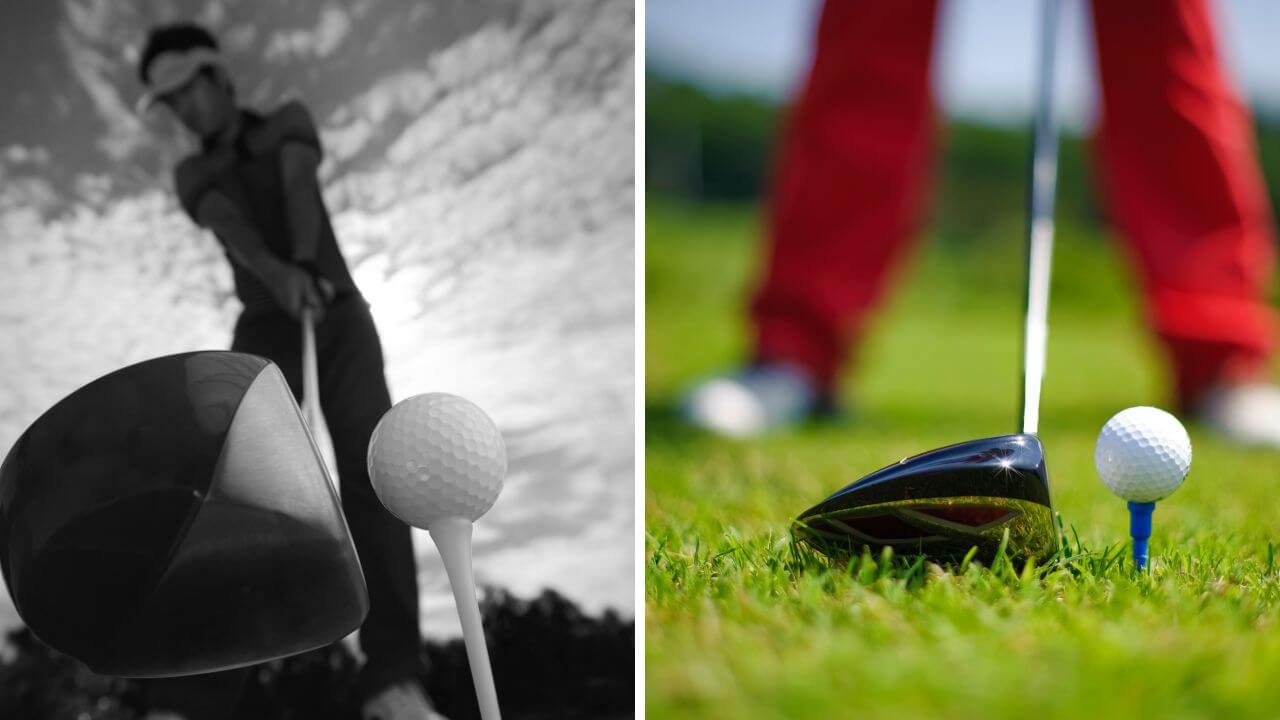
What is Smash Factor in Golf
Lower Body Power
The swing starts from the ground up. Effective lower body movement is essential:
- Maintain posture and spine angle in the backswing
- Allow hips to rotate back slightly trailing the shoulders
- Transfer weight smoothly to the back foot on the backswing
- Clear hips fully on the downswing to make room for arms
- Drive into lead foot, straightening knee through impact
Rotating around a steady lower body builds stability to unleash power.
Harness Torso Power
The midsection powers the swinging motion:
- Turn the upper body fully on the backswing coiling the torso
- Feel ribs rotate over hips to begin the downswing
- Sequence hips clearing then shoulders uncoiling
- Rotate hips and shoulders fully through impact
- Avoid excessive lateral bend swaying off the ball
Unleashing the torso whip builds speed.
Optimize Arm and Wrist Action
Proper arm positioning and wrist hinging are essential:
- Keep the lead arm tucked close to the chest in the backswing
- Let wrists hinge naturally up and then down to avoid strain
- Keep lead arm straight with wrist flat at the top of the backswing
- Maximize the width of the arc in the downswing for speed
- Release wrists fully through impact
- Extend arms outward towards the target after contact
Balanced hand and arm action optimize club delivery.
Common Power Leaks
Some swing errors sap power:
- Excessive lateral sway off the ball
- Overly restricted hip and shoulder turn
- Gripping too tightly constraining wrists
- Casting wrists early on the downswing
- "Picking the ball" by straightening up on the downswing
- Poor weight transfer and lower body stability
Detect your power leaks and correct them.
Drills to Increase Power
Useful power-building drills include:
- Full swing mirrors and video - Monitor positions
- Alignment stick hip turn checks - Maximize turn
- Impact bag release - Groove wrist snap
- Wall chest push - Feel chest driving swing
- Split grip drills - Permit free wrist action
- Swing smooth half-shots - Optimize sequencing
Practice drills gradually build faster speed.
Power Swing Thoughts
Use these swing thoughts to maximize power:
- Turn back fully then clear hips rapidly
- Drive into the front foot for solid weight transfer
- Keep back to target longer unleashing torso whip
- Release wrists fully through impact
- Swing aggressively through the ball while extending your arms
- Feel centered swing arc width for maximum speed
Implement swing keys that maximize your power moves.
Benefits of Power
Increased swing speed provides advantages:
- Added distance off the tee and on longer clubs
- Ability to reach more par-5s in regulation
- Shorter approach shots into greens
- Easier clearing of hazards and other obstacles
- Higher ball flight reaching peak altitude
- More backspin for better wedge shot control
Persistently work to develop a powerful, athletic swing. Mastering efficient mechanics will help you gain length and consistency.
5. Fixing Fat and Thin Shots with a Beginner Golf Swing
Making inconsistent contact is a common challenge for beginner golfers. Fat shots occur when the bottom of the swing arc contacts the turf before the ball, taking a deep divot.
Thin shots have the bottom of the arc beyond the ball, with the clubhead reaching it first. Both shots lose distance and accuracy.
Causes of Fat Shots
Fat strikes stem from a swing bottoming out prematurely:
- Swaying laterally rather than turning upper body
- Hitting too much from the inside with the club shaft steepening
- Straightening up during downswing losing spine angle
- Letting upper body get ahead of lower body
- Dropping or dipping lead shoulder towards the ball
- Poor weight transfer keeping too much on the back foot
Shallowing the swing plane is key to fixing fat contact.
Causes of Thin Shots
Thinning the ball results from the swing bottom being too far past the ball:
- Swaying back during the backswing and not clearing hips
- Having too flat of a swing plane with the club coming too far outside
- Scooping or picking the ball by straightening up through impact
- Upper body getting too far behind the lower body
- Over-rotating shoulders past hips through impact
- Weight staying too far back not releasing through the shot
Steepening the swing and maintaining posture prevents thin shots.
Drills to Fix Inconsistent Contact
Useful drills for solid contact include:
- Brush the grass drill - Helps shallow overly steep plane.
- Impact bag work - Grooves proper weight transfer.
- Swing plane mirrors - Provides visual feedback.
- Half-swing checkpoints - Reinforce proper positions.
- Alignment stick checks - Confirms desired spine angles.
- Exaggerated follow-through - Fully releases the body.
- Choke down on irons - Naturally shallows the plane.
Practice ingrains sound impact positions.
Swing Adjustments for Consistent Contact
Making adjustments can get you flush strikes:
For fat shots
- Maintain spine angle descending into the ball
- Allow hips to fully clear on the downswing
- Don't release the club too early
- Swing slightly more outside-in
- Ensure weight moves forward through impact
For thin shots
- Maintain posture and avoid straightening up
- Let hips clear fully before unleashing shoulders
- Stay behind the ball through impact
- Swing more inside-out around the body
- Fully release hands and clubhead through the ball
Match adjustments to your specific swing errors.
Benefits of Solid Contact
Flushing shots provide advantages:
- More greens hit in regulation
- Improved distance and accuracy
- Increase in fairways hit
- Ability to compress the ball fully with irons
- Consistently clean ball-striking
- Enhanced shot-making skills and finesse
Solid contact leads directly to lower scores.
Making a centered impact requires discipline and practice. Get lessons to diagnose your specific causes. Mastering clean contact will elevate your beginner game dramatically.
6. Gaining Directional Control with Your Beginner Golf Swing
For beginners, curving shots dramatically offline or launching them unpredictably is common. Developing directional control requires coordinating the clubface and swing path to send the ball on your intended line. Mastering proper alignment, grip, ball position, and swing mechanics will tame your trajectory.
Clubface Alignment
The clubface angle relative to your target line chiefly determines the starting direction:
- Aimed left of target promotes draws/hooks
- Aimed right promotes fades/slices
- Align clubface square to target for straight shots
- Check alignment meticulously before each shot
Clubface alignment influence depends on the swing path.
Swing Path Basics
Matching your path to the desired shot shape is key:
- Outside-in path amplifies a rightward aimed clubface promoting draws
- Inside-out path enhances an aimed left clubface promoting fades
- Swinging down the target line with a square face produces straight shots
Shape shots by coordinating face angle and path direction.
Grip Basics
Your grip largely controls the clubface:
- Stronger grip closes clubface promoting draws
- Weaker grip opens face promoting fades
- Maintain normal grip to keep face square
Avoid overly weak or strong hand positions.
Ball Position Adjustments
Strategic ball placement also influences direction:
- More forward encourages draws and prevents slices
- More rearward promotes fades and prevents hooks
- Center for neutral shots
Consider adjusting from the standard position to shape certain shots.
Drills for Better Control
Useful practice drills include:
- Draw and fade rehearsals on range
- Hitting off angled lies to exaggerate path
- Checking alignment setup dispersion
- Hitting extra balls checking face angles
- Swinging with guide rods or rails
- Mirror and video checks of swing mechanics
Controlling curves and shape requires practice.
Diagnosing Direction Issues
If struggling with a particular miss:
- Heel or toe strikes - Adjust ball position and check alignment
- Behind shots - Ensure weight shifts forward
- Hooks - Grip may be too strong or overdrawing
- Slices - Grip may be too weak or path too inside-out
Fix the root cause, not just the symptom.
Benefits of Control
Developing shot-making skills provides advantages:
- Ability to shape shots strategically
- Correcting for swing flaws to hit intended targets
- Improved capability from uneven lies or obstructions
- Adapting trajectory for distance control
- Versatility depending on weather, course conditions
Directional control is essential for scoring and success.
Avoid overly technical fixes. Develop a feel and instinct for curving shots purposefully. Your directional precision will improve steadily with mindful practice.
7. Finding Your Optimal Beginner Golf Swing Tempo
Tempo relates to the speed, rhythm, and timing of your golf swing. Having a smooth, controlled tempo synchronizes your body parts for efficient mechanics and consistency.
As a beginner, a relatively slower backswing with steady acceleration into the ball typically produces the best outcomes. Matching tempo to your strength and flexibility while maintaining balance is key.
Backswing Tempo
Keeping your backswing measured promotes consistency:
- Avoid rushing the backswing, let it build gradually
- Go as far back as flexibility permits, no farther
- Match length to torso turn, don't over-swing arms
- One smooth pace back, no abrupt motions
- Should take about 3 seconds to reach the top
A smooth tempo sets up solid body mechanics.
Transition Tempo
The transition starts your downswing:
- Don't abruptly jerk or yank club down
- Weight shift should trigger a measured transition
- Arms, wrists, and club should follow the body
- Maintain the same steady tempo as the backswing
Rhythmical motion retains control and balance.
Downswing Tempo
Your downswing aggressively accelerates into the ball:
- Gradually build speed shifting weight forward
- Clear hips, then aggressively pull with core muscles
- Wrists unhinge rapidly through impact
- Tempo increases but stays in sync
Controlled acceleration optimizes clubhead speed.
Common Tempo Errors
Flawed tempo patterns cause inconsistency:
- Rushing the backswing
- Abrupt, jerky transition
- Overly fast or tense downswing
- Inconsistent fluctuations in pace
- Losing synchronization between body parts
Detect your personal tempo errors.
Drills for Ideal Tempo
Useful tempo drills include:
- Swing with a metronome or rhythmic cue
- Rehearse smooth, flowing practice swings
- Swing gently with feet together to control sway
- Choke down for shorter, more controlled swings
- Hit half-shots focusing on steady, balanced motion
- Swing easy pitches exaggerating tempo contrasts
Practice aids instill an optimal pace.
Finding Your Tempo “Feel”
Determining your ideal tempo feel takes experimentation:
- Test different backswing lengths to find optimal control
- Exaggerate smooth transitions, don't rush them
- Try some aggressive downswings for increased awareness
- Identify if you naturally swing faster or slower
- Mimic a pro model swing of similar style to gauge rhythm
- Stick with a tempo that synchronizes your moving parts
Discover your personal optimal tempo.
Benefits of Solid Tempo
A smooth, cohesive tempo provides advantages:
- Consistency and repeatability swing to swing
- Efficiency transferring power to the ball
- Balance, great footwork and weight shift
- Solid impact and ball-striking
- Maximized clubhead speed and power
- Reduced tension, stiffness, and poor positions
Tempo ties your swing together for better golf.
Developing an efficient swing tempo takes self-awareness. Seek lessons to create feel-based tempo cues that stick. Mastering a smooth pace early will ingrain the blueprint for powerful, consistent ball striking.
8. Building Consistency in Your Beginner Golf Swing
Inconsistency is extremely common among beginner golfers. One great shot is often followed by a poor one. Developing a repetitive swing requires ingraining technically sound mechanics through quality practice. A consistent swing synchronizes your body parts for efficiency and control.
Grip and Alignment
A repeatable setup is crucial:
- Use the same grip each shot with proper hand placement
- Check exact alignment before each shot without rushing
- Replicate proper posture and ball position consistently
This builds your swing on a neutral foundation.
Tempo and Rhythm
A smooth, rhythmic swing tempo promotes consistency:
- Maintain the same pace back and through your swing
- Eliminate abrupt motions or changes in speed
- Find a flow that synchronizes your body sequence
- Develop a feel-based tempo swing cue
Rhythm and timing eliminate compensations.
Proper Mechanics
Sound fundamentals are key:
- Position the club properly in backswing and downswing
- Transfer weight fully to lead side through impact
- Release hands and clubhead fully through the ball
- Turn shoulders fully on backswing and downswing
- Maintain spine angle and posture throughout motion
Repeating sound mechanics creates repeatability.
Balance and Footwork
Solid balance prevents compensations:
- Settle into a balanced address position
- Maintain posture throughout backswing
- Drive lower body powerfully into lead foot through impact
- Control head and upper body against sway
- Finish in a solid balanced position
Balance keeps swings on plane.
Practice with Purpose
Thoughtful practice develops instinctual motions:
- Perform swing rehearsals checking positions
- Groove key positions through impact
- Do slow-motion drills emphasizing technique
- Use training aids to build a kinesthetic feel
- Perform focused, high-quality range sessions
Purposeful practice ingrains technique.
Other Consistency Tips
Other useful tips include:
- Stick to the same pre-shot routine
- Visualize your ideal swing
- Eliminate technical swing thoughts before shots
- Embrace swing feel, not positions
- Swing smoothly within your natural capability
- Stay mentally present on each shot
Simplifying your mental process improves consistency.
Building a repetitive golf swing requires patience and discipline. Get coaching to correct flaws in positions or mechanics. With focused practice, your consistency will improve dramatically from shot to shot.
9. Beginner Golf Swing Mistakes to Avoid
All golfers develop swing flaws and miscues when starting out. By knowing the most common beginner mistakes, you can diagnose your issues faster and correct them. Avoiding these pitfalls early provides massive long-term benefits.
Grip Issues
Faulty grip technique causes many issues:
- Holding club too tightly in palms instead of fingers
- Gripping down the shaft, restricting wrist hinge
- Wrong hand placement leading to open or closed clubface
- Improper grip pressure leading to twisting and tension
Check fundamentals like neutral grip and hand placement.
Setup Errors
Improper setup makes a sound swing difficult:
- Feet, knees, and hips aligned left or right of the target
- Ball position too far forward or back
- Insufficient knee flex restricting turn
- Excessive secondary spine tilt away from the target
- Hands held too low or club shaft leaning back
Monitor basics like alignment, posture, and ball position.
Backswing Flaws
Common backswing mistakes include:
- Overly restricted shoulder and hip turn
- Excessive dipping or dropping of lead shoulder
- Lifting or straightening lead leg
- Overly flat takeaway plane with hand path to outside
- Bending lead arm excessively flattening swing
Ensure full turn, stable lower body, and proper hand path.
Transition and Downswing Issues
Some beginners struggle with the transition:
- Casting club by letting wrists break down early
- Swaying laterally with upper and lower body disconnect
- "Coming over the top" due to an overly flat plane
- Throwing hands at the ball leading to inconsistent contact
- Pulling up out of posture before impact
Keep connection and width coming down to prevent common flaws.
Miscellaneous Faults
Other mistakes to avoid:
- Looking up before impact
- Not transferring weight fully through downswing
- Gripping down on club to guide swing artificially
- Overanalyzing positions hampering fluidity
- Neglecting short game skill development
- Not getting professional instruction
Detect and address your personal swing demons.
Benefits of Error Elimination
Avoiding traps leads to:
- More powerful, fluid swing
- Squarer clubface and solid impact
- Better weight shift and footwork
- Maximum speed without tension
- More consistency and repeatability
- Faster skill progression and learning
Lessen mistakes now so sound technique becomes automatic.
Beware of falling into common beginner pitfalls. Stay aware of tendencies, get coaching, and engrain proper motions through practice. You’ll bypass many frustrating errors others commonly encounter.
10. Timeline for Developing a Good Beginner Golf Swing
Many new golfers want to expedite rapidly improving their swing technique. While a sound swing can come along relatively quickly, ensuring true consistency and repeatability takes dedicated practice. Avoid expecting perfection overnight. Setting realistic timelines and benchmarks helps gauge your development.
1-3 Months
Early progress can be swift if practicing properly:
- Groove key setup positions like grip, stance and posture
- Ingrain basic takeaway motions and backswing action
- Develop balance and synchronization in motion
- Make consistent contact and get the ball airborne
- Learn basic swing adjustments for shot shaping
First focus on solid fundamentals before power.
3-6 Months
Making advances takes persistence:
- Increase flexibility allowing fuller turns and motion
- Improve footwork and weight transfer
- Establish more fluidity and swing rhythm
- Control clubface through impact more consistently
- Strike irons purer and compress the ball better with woods
Build techniques requiring body coordination.
6-12 Months
Significant refinement takes time:
- Make a truly repeating swing with consistent mechanics
- Shape shots intentionally with curve and trajectory
- Produce consistent contact and crisp ball-striking
- Build more powerful and athletic motion
- Develop reliable short-game skills around greens
Integrate separate skills into a cohesive game.
1-2 Years
Getting truly skilled demands dedication:
- Handle uneven lies, obstructions, and course management
- Strike all club types cleanly with efficient mechanics
- Control distance reliably with each club
- Compete under pressure with minimal technique erosion
- Build skills holistically to break 100, 90, 80, etc.
Take skills from range to full golf course performance.
Beyond 2 Years
Elite play requires lifelong work:
- Maintain sound mechanics while building advanced skills
- Develop nuanced touch and finesse around greens
- Master distance control, shot shaping, and trajectory
- Hone championship course management and recovery ability
- Handle nerves and execute under pressure
There is always refinement to be made.
Key Perspectives
Keep realistic expectations when learning golf:
- Accept variance in individual learning curves
- Don't compare yourself to others or get frustrated
- Stay disciplined and avoid expecting instant success
- Make golf an enjoyable journey for a lifetime
Patience and perseverance pay off.
Improving at golf takes sustained effort. But stick with the process, get coaching, and continue mastering the skills that make an effective swing. Before long, you'll develop capabilities you didn't think possible as a beginner.
Conclusion:
- Mastering basics like grip early is crucial
- Focus on swing path, club face, and ball position to improve directional control
- Developing repeatable tempo and swing plane takes practice and training
- Getting professional instruction helps beginners build proper fundamentals faster
FAQ's - Beginner Golf Swing
What are some beginner golf swing tips?
Some beginner golf swing tips include keeping your head down, maintaining a straight left arm, and using these 3 easy golf tips.
How can I improve my golf swing?
To improve your golf swing, you can take golf lessons, practice at the driving range, and use golf swing tips that cover the basics.
What are the best golf swing tips?
Some of the best golf swing tips include keeping your left arm straight, using a proper golf grip, and striking the ball with the right technique.
Do you have any golf tips for beginners?
Yes, here are some golf tips for beginners: focus on your golf setup, hit the ball with a smooth swing, and keep your head still during the swing.
How can I learn the basics of golf swing?
To learn the basics of golf swing, you can start by practicing at the driving range, taking golf lessons, and using easy golf tips for beginners.
Can you give me some advice on how to hit the ball straight?
Some tips to help you hit the ball straight are: maintain a good posture, keep your left arm straight, and strike the ball with a square clubface.
What are some common mistakes made by golfers?
Some common mistakes made by golfers include lifting the head during the swing, swinging too hard, and using an incorrect grip.
How can I improve my golf game?
You can improve your golf game by practicing regularly, taking golf lessons, and focusing on specific areas of your game that need improvement.
Are there any specific tips for improving the golf swing?
Yes, here are 3 golf swing tips that cover 90% of the swing: keep your left arm straight, rotate your hips, and generate power from your lower body.
What role does the wrist play in the golf swing?
The wrist plays a crucial role in the golf swing as it controls the clubface position and helps generate power in the swing.
Thank you for visiting, and we hope to see you back soon!
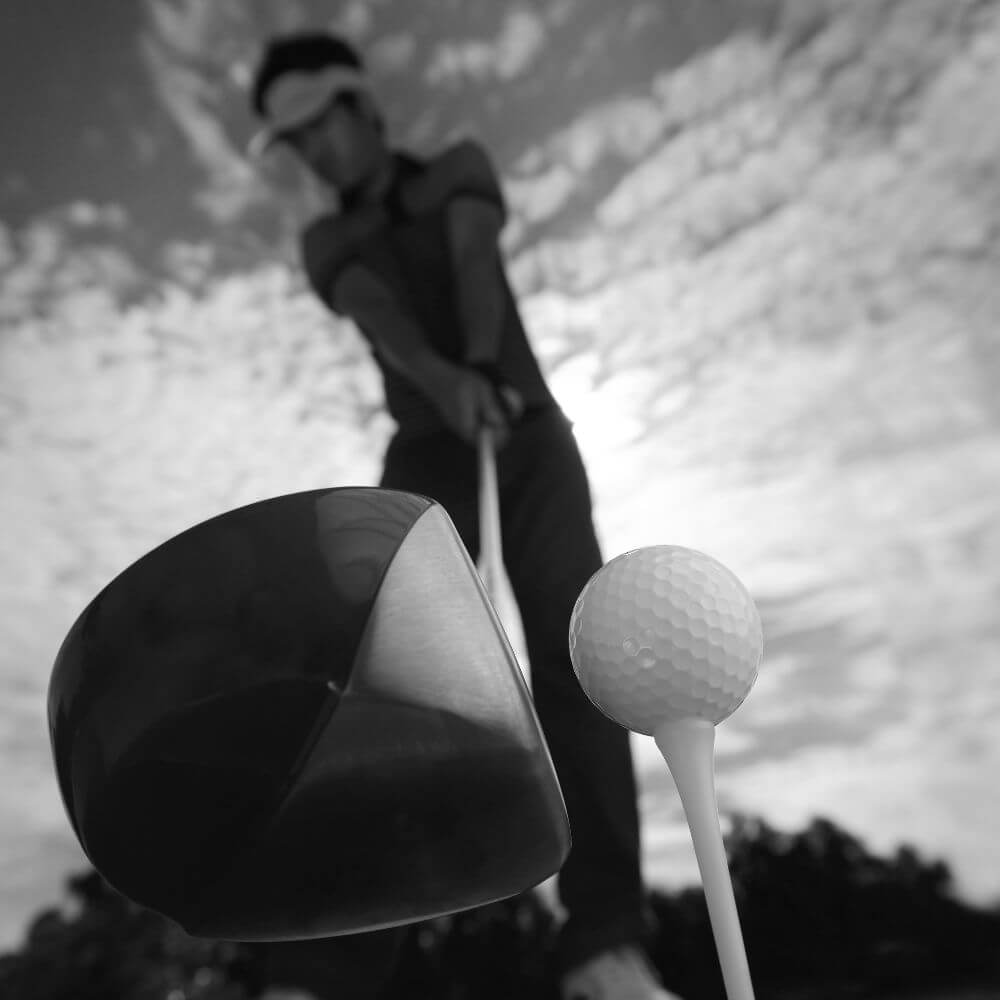
How to Drive a Golf Ball for Beginners


